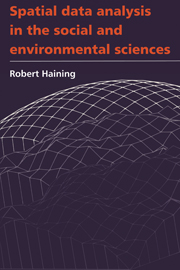Book contents
- Frontmatter
- Contents
- List of tables and displays
- Preface
- Acknowledgements
- PART A Introduction to issues in the analysis of spatially referenced data
- PART B Parametric models for spatial variation
- PART C Spatial data collection and preliminary analysis
- 5 Sampling spatial populations
- 6 Preliminary analysis of spatial data
- PART D Modelling spatial data
- Postscript
- Glossary
- References
- Index
5 - Sampling spatial populations
Published online by Cambridge University Press: 05 August 2012
- Frontmatter
- Contents
- List of tables and displays
- Preface
- Acknowledgements
- PART A Introduction to issues in the analysis of spatially referenced data
- PART B Parametric models for spatial variation
- PART C Spatial data collection and preliminary analysis
- 5 Sampling spatial populations
- 6 Preliminary analysis of spatial data
- PART D Modelling spatial data
- Postscript
- Glossary
- References
- Index
Summary
Introduction
This chapter examines the problems that arise in sampling a surface for purposes of estimating its properties. We shall assume that the surface is continuous or very nearly so. Often data are made available on a predetermined grid or framework such as a network of established weather stations, pixels on a remotely sensed image, areas or tracts in a census survey. In this chapter, however, we consider the situation where the analyst can choose the framework for data collection. We consider three categories of spatial sampling problem.
Category I: Problems concerned with estimating some non-spatial characteristic of a spatial population, for example the frequency distribution of areal values, or an areal mean, or a total, proportion or intensity value. So, we might wish to estimate the mean or total level of precipitation in a basin, average levels of household income, the proportion of infected individuals in an area during an epidemic, or the proportion of an area with high levels of pollution.
Category II: Problems where the spatial variation of some variable is specifically required, either in the form of a map or in the form of a summary measure (such as a variogram or correlogram) to highlight important scales of variation. Included here are situations where the objective is to ensure efficient spatial interpolation (in geology, geomorphology or meteorology for example) for purposes of converting scattered point data to map form.
[…]
- Type
- Chapter
- Information
- Spatial Data Analysis in the Social and Environmental Sciences , pp. 171 - 196Publisher: Cambridge University PressPrint publication year: 1990
- 3
- Cited by



